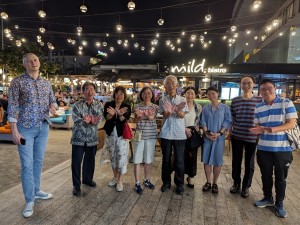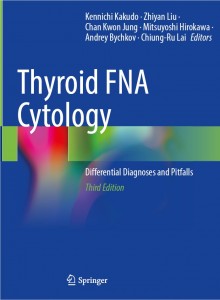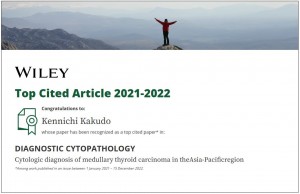This web site is conducted by Kennichi Kakudo, MD, PhD, professor emeritus of Wakayama Medical University and visiting professor of Kindai University, Faculty of Medicine, Japan. I am also a visiting professor of Shandon University and Taishan Medical University, China. It is designed for a personal communication with you to discuss one of the followings; 1) (to pathologists) about pathology and its future directions and case consultation, 2) (to patients) about your diagnosis and advises for your decision making, as a second opinion consultation and 3) (to physicians in the other fields), as consultation and quality control for your patients’pathology reports.
Although the most parts of this home page are written in Japanese, you may enjoy my English pages and my scientific publications written in English. Please send your comments and discussion to me at E-mail: kakudo@thyroid.jp
Second Opinion Consultation on Thyroid Diseases from Patients.
It is a well-known fact that there are severe observer disagreements in benign and malignant diagnosis of thyroid tumors (Hirokawa M, et al.: Observer variation of encapsulated follicular lesions of the thyroid gland. Am J Surg Pathol, 26:1508-1514, 2002 & Lloyd RV, et al.: Observer Variation in the Diagnosis of Follicular Variant of Papillary Thyroid Carcinoma. Am J Surg Pathol, 28(10):1336-1340, 2004). Although an accurate diagnosis is essential to ensure the most effective treatments, over-diagnoses and over-treatments are serious problems in some areas including thyroid tumors (Esserman LJ et al: Addressing overdiagnosis and overtreatment in cancer: a prescription for change. Lancet Oncol, 15:234-242, 2014.). Second opinion consultation will solve some of the problems and lead you to most proper treatments with confidence.
How to get a second opinion from Dr Kakudo.
Ask your doctor to obtain a second opinion from Dr Kakudo showing this HP ( http://www.kakudok.jp/english/ ), and then your physician or hospital send me your histological slides and a case summary to the following address. As no official request form prepared in this HP, please includes followings in your request letter; 1) contact address, E-mail address and names where my second opinion diagnosis should be sent, 2) patient name, date of birth, and PDFs (copies) of pathology reports (first opinion) together with histological slides, 3) a case summary including clinical diagnosis and medical history of the patient, 4) questions and points where you (patient) most concern and 5) address the histological samples should be returned.
(Gross photos of resected specimens and image files such as ultrasound, CT or MRI are desirable but not must.)
Address where samples and request should be sent.
K. Kakudo, MD, PhD
Nishitomigaoka 3-11-2,
Nara-city, Nara, 631-0006 Japan.
E-mail: kakudo@thyroid.jp
Consultation Fee: $200.00(Two hundred US dollars).
Please transfer above sum to
The Bank of Tokyo-Mitsubishi UFJ, Ltd, Japan (bank code: 0005).
Account holder: Kakudo Kenichi
Account number: 5054926 and branch number: 458 (Kintetsu-Gakuenmae branch).
After confirmation of receipt, the samples will be returned to the address you indicated.
Risk stratification of thyroid nodules with fine-needle aspiration cytology presented at the 2020 KTA Virtual Annual Meeting in Daegu, Korea.
Thyroid nodules: Are they malignant or indolent tumors?” presented in The 1stInternational Symposium on Overdiagnosis of Juvenile Thyroid Cancer held in Nara Japan.
Thyroid cancer in young people often shows metastasis and recurrence. However, the prognosis is excellent, which puzzled researchers for a long time. A part of this mystery has been understood from the recent accumulation of clinical evidence. Papillary thyroid microcarcinomas (PTMs) are found frequently in adults after their thirties. They hardly grow after middle age, and a considerable number of them decrease in size. In addition, during the observation trails, no patient died from thyroid cancer, and no patient experienced anaplastic transformation. The results of large-scale screening for thyroid cancer in young people in Fukushima Prefecture show that the frequency of thyroid cancer, which can be found only by ultrasound, increases rapidly after teens, and that the growth of these cancers slows down as they grow. Therefore, its growth is speculated to stop in the future. >From this evidences, the natural history of thyroid cancer may be as follows. Most thyroid cancers occur in childhood and rapidly grow in their 10s to 20s, causing metastasis and invasion. A small proportion of these grow to a size that requires treatment in early life, but the rest cease to grow, remaining as a PTM throughout the lifetime. Thyroid cancer, which leads to cancer death in middle-aged and older people, is fundamentally different from thyroid cancer in the young or PTM. We distinguish this type of cancer that occurs in young people from conventional thyroid cancer and call it juvenile thyroid cancer. It is also designated as self-limiting cancer (SLC). SLC metastasizes and invades like thyroid cancer that is seen in the middle-aged and older patients. However, due to its limited growth ability, it rarely kills patients. Early diagnosis of SLC is prone to cause the harm of overdiagnosis, while it does not improve prognosis or quality of life. Besides, in young patients, because a small cancer is likely to be at its rapidly proliferating and spreading phase, a small surgery for small cancer can result in an increase in the recurrence rate. It has been said that early diagnosis and early treatment are the golden standards for cancer. However, SLC’s existence, the details of which have been clarified for the first time in thyroid cancer, overturned this common sense. We should be fully aware of the fact that in some cancers, early diagnosis can harm patients.
International Thyroid Cancer Symposium was held at the IRCAD in Taiwan on October 4, 2015.
Please find the following link for my presentation, and my title is “Classification of the thyroid follicular cell tumors – identification of borderline lesions-”.
Things usually move very slowly but sometimes the change may occur dramatically. Pathology is a very old science and usually stable and immutable, however we are facing to an epoch making drastic change in diagnosis of thyroid tumors. This is my history of diagnostic criteria for encapsulated follicular variant papillary carcinoma. The pathology diagnosis is no longer a gold standard for cancer diagnosis in thyroid tumors. You will find it in my lecture.
The 55th Annual Meeting of the Japan Thyroid Association
Centennial of Hashimoto Disease International Symposium I ”Future Perspective of Thyroid Autoimmunity”
2012.12.1 ACROS Fukuoka B2F Event Hall
[Session 5]
Chairs:
Yuji Nagayama (Nagasaki University Graduate School of Biomedical Sciences, Japan)
Wilmar M.Wiersinga (University of Amsterdam, The Netherlands)
Speakers:
3)IgG4 Thyroiditis and Fibrotic Variant of Hashimoto’s Disease
Kenich Kakudo, Yaqion Li
(Department of Medical Technology, Kobe Tokiwa University, Japan
Department of Human Pathology, Wakayama Medical University, Japan)
AOTA Bali and the University of Indonesia Residency Program
2024/06/02
category: To Clinician , To pathologist comment: (0)
Thyroid FNA Cytology, Differential Diagnoses, and Pitfalls
2024/03/03
category: To Clinician , To pathologist comment: (0)
Wiley Top Cited Article 2021-2022
2023/02/23
category: To Clinician , To pathologist comment: (0)







